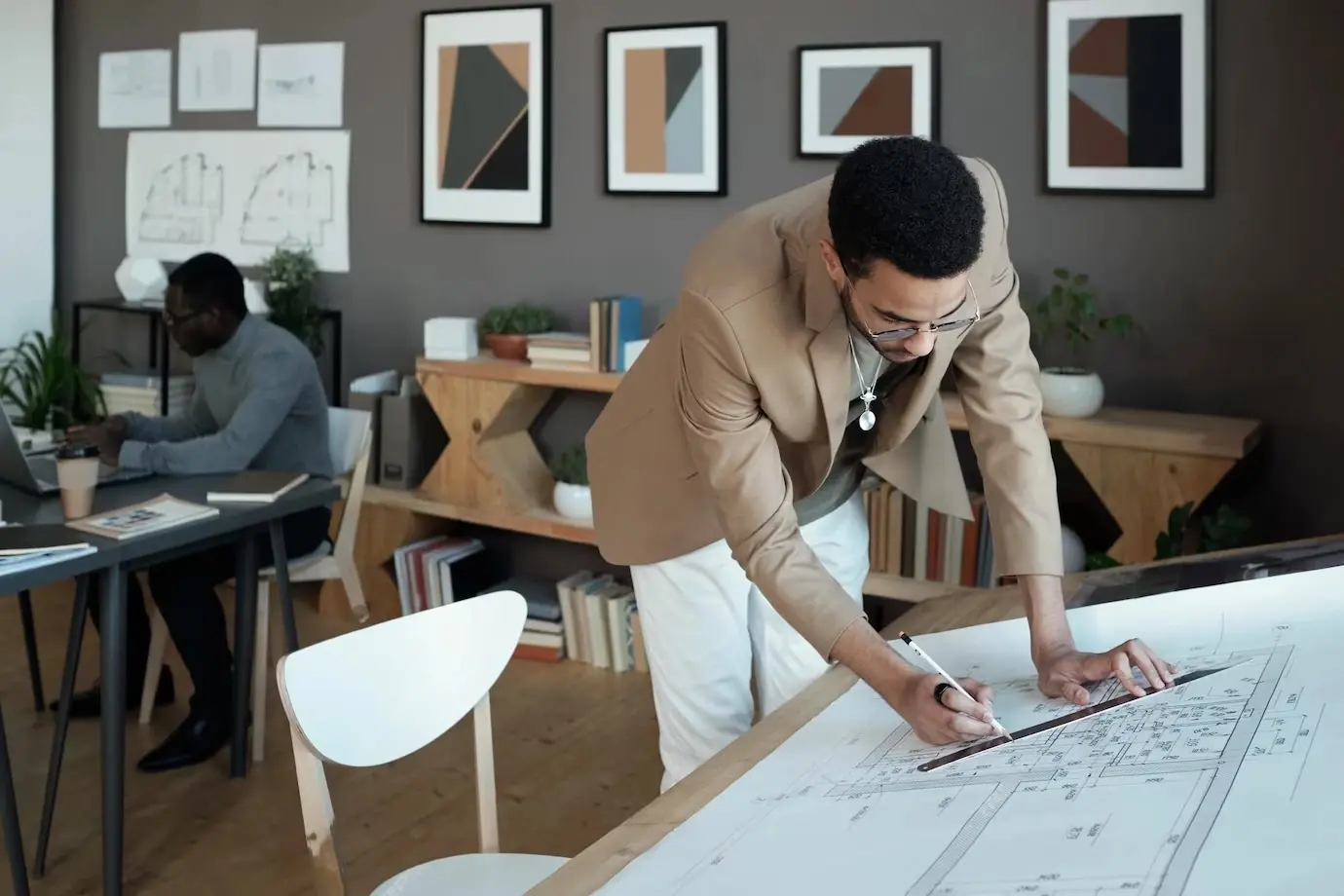Interior Design Career as a Path to Creative Success
- Interior Design
Interior Design Career as a Path to Creative Success
Contact us
Bengaluru
Campus 1 : JD School of Design, No. 18-1, Brigade Road, Bengaluru,Karnataka – 560 001.
Campus 2 : No. 40, Swan House, 4th Cross, Residency Road, Bengaluru, Karnataka – 560001.
Goa
Musthtifund Saunstha , Near Mahalaxmi Temple,Dada Vaidya Road, Goa-403001
The landscape of 2024 offers a Prominent Interior Design Career. Beyond traditional roles, professionals can explore specializations such as furniture and exhibition design, lighting, kitchen design, architecture, and more. This variety underscores the versatility and promising prospects within the interior design field.

We will delve into the captivating world of Interior Design Career Opportunities. We’ll uncover the secrets behind its appeal, discover how much Interior Design Career Salary in India, and gain insights into How to Become an Interior Designer. Additionally, we’ll explore whether interior design is a good career in India.
Who is an Interior Designer?
An interior designer is a skilled professional who envisions and transforms interior spaces, combining aesthetics with functionality. These creative individuals enhance the visual appeal, usability, and ambiance of indoor environments. Interior designers consider elements such as colour schemes, furnishings, lighting, and spatial arrangements to create cohesive, pleasing, and purposeful spaces tailored to clients’ needs and preferences. Their expertise extends to residential, commercial, and institutional settings, ensuring designs align with safety standards and regulations. Interior designers often collaborate with architects, contractors, and clients to bring their creative visions to life.
Is Interior Design a Good Career?
Embarking on an Interior Design Career Requirements opens doors to a world where creativity meets functionality. As interior designers, professionals wield the power to reimagine and enhance the spaces we inhabit. This dynamic field not only allows individuals to express their artistic flair but also demands a keen understanding of spatial dynamics and design principles.

The allure of an interior design career lies in its versatility. Whether crafting cozy homes or conceptualizing cutting-edge office spaces, interior designers constantly engage with diverse projects. This diversity keeps the profession exciting and offers continuous learning opportunities. Moreover, the rising importance placed on well-designed environments amplifies the demand for skilled interior designers, presenting a plethora of career prospects.
Beyond creative fulfillment, interior design proves to be a lucrative path. As the industry thrives on innovation, those with a knack for blending aesthetics with functionality find themselves in high demand. This demand translates into financial rewards, making interior design not just a good career but a profession that allows individuals to shape how they experience and interact with spaces. In essence, learning How to Become an Interior Designer is a voyage into a world where passion converges with practicality, resulting in a fulfilling and prosperous journey.
Roles and Responsibilities of an Interior Designer
The realm of an interior designer’s responsibilities is expansive, encompassing tasks that go beyond mere decoration. These professionals are architectural alchemists, seamlessly blending aesthetics with functionality. Key roles and responsibilities of an interior designer include:
- Space Planning: Interior designers meticulously analyse available space, optimising functionality, and flow. They determine the strategic placement of furniture, fixtures, and other elements to create a harmonious and efficient layout.
- Material Selection: Interior designers are curators of spaces, selecting materials such as flooring, wall coverings, furniture, and accessories to achieve the desired look and feel. Considerations include durability, sustainability, and maintenance requirements.
- Collaboration: Effective communication is integral as interior designers collaborate closely with architects, contractors, and other professionals involved in construction or renovation projects. Successful implementation of the design vision requires seamless collaboration.
- Project Management: Interior designers wear the hat of project managers, overseeing various aspects including budgeting, scheduling, and coordination with contractors and vendors. They ensure projects stay on track and meet deadlines.
- Problem-Solving: Challenges are inevitable, and interior designers must be adept at finding creative solutions. This could involve adjusting the design, addressing unforeseen issues, or making real-time decisions to keep the project on course.
- Client Consultation: Understanding clients’ needs, preferences, and lifestyles is paramount. Thorough consultations help gather information about clients’ tastes, budgets, and functional requirements, ensuring the design aligns with their vision.
- Codes and Regulations: Interior designers must be knowledgeable about building codes, safety regulations, and accessibility standards. Compliance with these guidelines is crucial for the well-being of occupants and the success of the project.
How to Become an Interior Designer

How to Start a Career in Interior Design involves several key steps to acquire the necessary skills and credentials. Here’s a concise guide:
- Education: Pursue a formal education, ideally through a recognised institution or university. Completing a degree or diploma in interior design provides foundational knowledge in design principles, materials, and project management.
- Specialised Courses: Consider enrolling in a specialised course at JD Institute to enhance specific skills. The course can provide a competitive edge in the industry.
- Internship or Apprenticeship: Gain practical experience through internships or apprenticeships with established interior designers or design firms. This hands-on experience is invaluable for applying theoretical knowledge to real-world projects.
- Build a Portfolio: Assemble a comprehensive portfolio showcasing your best work, including design projects completed during your education and any internship experiences. Interior Design Portfolio is crucial for impressing potential employers or clients.
- Networking: Connect with professionals in the interior design industry, attend industry events, and join relevant online forums. Networking helps you stay informed about industry trends, the Best Interior Design Jobs, and potential collaborations.
- Certification: While not always mandatory, obtaining certification from a recognised professional organisation can enhance your credibility and open up more career opportunities.
Remember, interior design is a dynamic field, and ongoing learning and adaptation to industry trends are essential for a successful career.
Future of Interior Design
The future of interior design is undergoing a significant transformation, propelled by technological advancements, societal shifts, and evolving design preferences. Moreover, a growing emphasis on sustainability is shaping environmentally conscious interior design practices, with designers incorporating eco-friendly materials, energy-efficient solutions, and sustainable practices. Wellness-centric design principles, adaptable spaces, cultural diversity, and the integration of digital collaboration platforms are further defining the industry’s trajectory.
In response to evolving lifestyles and needs, interior designers are creating multifunctional spaces and embracing personalized and bespoke design solutions. Additionally, there’s a notable shift towards resilient design strategies to address concerns about climate change and environmental impact. As the interior design landscape continues to evolve, designers who adeptly navigate these trends and remain attuned to the dynamic nature of the industry will play a crucial role in shaping its future.
Scope of Interior Design in India
The scope of interior designing in India is rapidly expanding with the flourishing real estate sector and a growing emphasis on design aesthetics. Interior designers are finding abundant opportunities in crafting well-designed residential, commercial, and hospitality spaces. Initiatives like “Make in India” and the emergence of smart cities contribute to the demand for skilled designers. As people increasingly prioritise well-designed living and working spaces, the role of interior designers in enhancing the functionality and aesthetics of these environments becomes pivotal. This trend is expected to drive sustained growth in the interior design sector in India.
How Much Interior Designers Earn in India
In India, interior designers’ earnings vary based on factors like experience, location, and project complexity. Entry-level professionals may start with salaries ranging from INR 3-5 lakhs per annum.
With mid-level experience, High Paying Interior Design Jobs can climb to INR 6-10 lakhs annually. Experienced designers, especially those associated with prestigious projects, can command salaries exceeding INR 15 lakhs per year, showcasing the lucrative potential within the Indian interior design industry. Renowned interior designers often become symbols of success, motivating emerging talents to pursue excellence in their careers.
In conclusion, the year 2024 unveils a vibrant realm of possibilities within the field of interior design. Aspiring individuals can embark on a fulfilling journey with diverse career paths, ranging from furniture and exhibition design to architecture and beyond. The dynamic nature of an Interior Design Career promises continual growth, making it an attractive and ever-evolving professional avenue.
